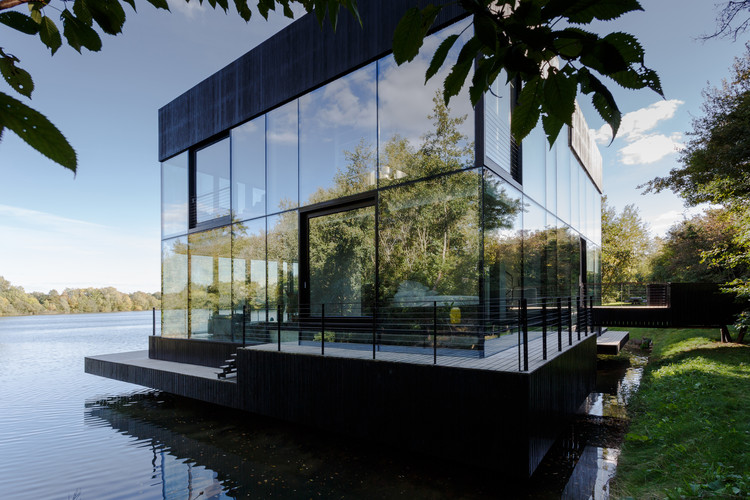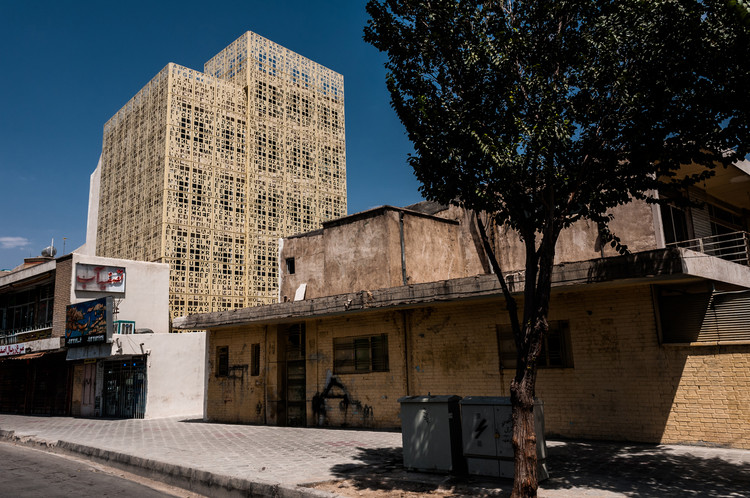AD Classics Centre Culturel Jean
2015-08-04 19:00
这些地点中的后一处-新喀里多尼亚太平洋岛屿群的首都-对那些至今仍未听说过的人来说可能是不合适的,因为在伦佐·皮亚诺的Tjibaou文化中心建成16年之后,但情况肯定并非如此:这一项目对努美阿市的变革性经济影响,丝毫不亚于任何声名显赫的歌剧院或博物馆的经济影响。自该中心建成以来,新喀里多尼亚已成为国际建筑聚光灯下的焦点,该建筑标志性外壳的优雅、短暂的设计为其岛屿和钢琴公司带来了同等的声誉和商业。
The latter of these locations—the capital of the Pacific island cluster of New Caledonia—may seem a misfit on this list to those who have still not heard of it, now sixteen years after the completion of Renzo Piano’s Tjibaou Cultural Center, but it most certainly is not: the transformative economic effect of this project on the city of Nouméa has been no less dramatic than that of any opera house or museum of greater renown. Since the Center's completion, New Caledonia has found itself in the international architectural spotlight, as the graceful, ephemeral design of the building's iconic shells has brought fame and business in equal parts to its island and to Piano’s firm.
新喀里多尼亚政府是否有意给该岛带来如此多的关注,在1991年,他们选择皮亚诺(Piano)作为唯一的邀请赛获胜者,这在很大程度上变得无关紧要。其目的是征求意见,建立一个庆祝新喀里多尼亚卡纳克文化的中心,并在此过程中缓和卡纳克人与该岛其他居民之间长期恶化的种族紧张局势。它将策划一场国际人才搜寻,以承认其本土文化,这是一种讽刺和批评之源,卡纳克人之间历史上紧张的关系和不断侵蚀的现代化影响,使这一问题更加令人心酸。
Whether the New Caledonian government ever intended such to bring so much attention to the island became largely irrelevant after they selected Piano as the winner of an invite-only international competition in 1991. Its objective was to solicit ideas for a center that would celebrate the Kanak culture native to New Caledonia, and in the process, smooth over ethnic tensions that had been chronically deteriorating between the Kanak people and the island’s other inhabitants. That it would orchestrate an international talent search to recognize its local culture was a source of irony and criticism, made even more poignant by the historically strained relationship between the Kanaks and the ever-encroaching influence of modernization.
委员会的核心目标是卡纳克人和新喀里多尼亚的欧洲后裔统治者之间漫长、复杂和经常对抗的历史。19世纪初被法国定居者殖民的格兰德泰尔岛遭受了近两个世纪的自然资源开发、文化压迫和长期的卡纳克奴役。在二十世纪末,该岛经历了一场旷日持久的血腥独立运动,代表卡纳克人部分地由让-玛丽·特吉布(Jean-Marie Tjibaou)领导,以他的名字命名,直到1989年他遇刺。正是在这种背景下,该项目被认为是早就应该承认的边缘化文化,并得到法国政府的资助。[1]
At the core of the commission's purpose was the long, complex, and often confrontational history between the Kanak people and New Caledonia’s European-descended rulers. The island of Grande Terre, which was colonized by French settlers early in the nineteenth century, had endured nearly two centuries of natural resource exploitation, cultural oppression, and long periods of Kanak enslavement. In the late twentieth century, the island underwent a protracted and varyingly bloody independence movement on behalf of the Kanak people led in part by Jean-Marie Tjibaou, for whom the Center is named, until his assassination in 1989. It was in this context that the project was conceived as a long-overdue recognition to a marginalized culture and given funding by the French government. [1]
不过,撇开政治不说,人们很容易理解陪审团在钢琴优雅设计中看到了什么,以及它是如何成为国际公认的目标的。建筑师们以传统的卡纳克酋长的房子为出发点,操纵和解构他们的形式,创造了一个圆形的,通风的贝壳的巨大序列。其中有十个沿着山坡伸展,高度从20米到28米不等,在太平洋海岸线上占据着制高点。在博物馆内部和之间,精心设计的博物馆空间队伍带着游客在亲密的室内围场和周围的岛屿景观之间来回穿梭。
Politics aside, however, it is easy to understand what the jury saw in Piano’s elegant design and how it became an object of esteemed international recognition. Sensitively using traditional Kanak chiefs’ houses as a starting point, the architects manipulated and deconstructed their form to create a monumental sequence of rounded, airy shells. Ten of them stretch along the hillside, varying in height from 20 to 28 meters and casting a commanding presence over the Pacific shoreline. Within and between them, a carefully choreographed procession of museum spaces takes visitors on a journey that weaves back and forth between intimate indoor enclosures and the surrounding island landscape.
Interior of a Kanak Chief's Hut. Image © Flickr user Eustaquio
卡纳克酋长小屋的内部。图片c Flickr用户Eustaquio
就像之前的卡纳克建筑师一样,皮亚诺的概念强调场地和环境的影响是设计和表现的决定因素。贝壳的形式协商了传统的建筑方法和一个锥形的,非物质化的轮廓,优美地发挥周围树木的纹理。建筑外部的空隙进入了建筑的规划和洞口,使工程从物理上向现场开放,并加深了居民的地域性。智能被动通风系统消除了对空调的需求,使建筑清洁、自然的空气供应成为该中心设计的一个经验性部分。即使是建筑集群的相互关系,按照类似于传统卡纳克村庄的宏伟规划的布局安排,也取决于封闭空间和外部空间之间的持续流动。[2]
Like the Kanak architects before them, Piano’s concept emphasizes the influence of site and environment as determinants of design and performance. The form of the shells negotiates a blend of traditional construction methods and a tapered, dematerializing profile that beautifully plays off the texture of the surrounding trees. Exterior voids worked into the plan and fenestrations in the building envelopes physically open the project to the site and deepen the inhabitants’ sense of place. An intelligent passive ventilation system removes the need for air conditioning, making the building’s clean, natural air supply an experiential part of the Center’s design. Even the interrelationship of building clusters, arranged in a layout similar to the grand allée plan of traditional Kanak villages, is dependent on a continuous stream of movement between enclosed and exterior spaces. [2]
效果是有机的和引人注目的。关于贝壳的美丽的不完全性引起了人们对正在进行的工作和废墟中的工作的似是而非的感觉,尽管如此,它们仍然令人深感满意。理想化地说,也许这些不完整的几何图形反映了卡纳克文化正在从古老的根源上继续成长和进化的情绪,即使新的条件要求它去适应它的形式。
The effect is organic and eye-catching. A beautiful incompleteness about the shells illicits seemingly paradoxical perceptions of a work-in-progress and a work-in-ruins that is nevertheless deeply satisfying. Idealistically, perhaps these incomplete geometries reflect the sentiment that Kanak culture is continuing to grow and evolve from ancient roots, even as new conditions require it to adapt its form.
Preliminary Plan/Elevation Composite Drawing
然而,对于建筑师的所有上下文敏感性,不可避免的不一致贯穿整个设计。这些结构的技术复杂程度与其内所展示的传统工艺之间的根本脱节说明了一个概念问题,破坏了该中心脆弱的遗产感和身份感。鉴于欧盟委员会复杂的政治背景,这是一个意料之外但却是恰当的主题,而且这个主题永远不会通过建筑完全解决。有人建议,该中心的技术在相互冲突的文化信息、设计冲动和系统目标之间起着中介作用[3],但这很可能只是对无法解决和有点分散注意力的冲突的乐观解读。
Yet, for all of the contextual sensitivities of the architects, inevitable inconsistencies pervade the design. A fundamental disconnect between the technological sophistication of the structures and the traditional craftsmanship exhibited within them illustrates a conceptual problem that undermines the Center’s tenuous sense of heritage and identity. This is an unintended but nevertheless fitting theme given the commission’s complex political context, and one that is never completely resolved through architecture. It has been proposed that the Center’s technology acts as a mediator between conflicting cultural messages, design impulses, and systemic objectives [3], but this is likely only an optimistic reading of an irresolvable and somewhat distracting conflict.
科技与传统的脱节是卡纳克人非常熟悉的局部和全球认同之间更大的弗兰普顿张力的一个方面。虽然该中心的形式抽象地美丽,在环境方面考虑周到,但它不可避免地与新喀里多尼亚的当地文化以及他们所属的建筑师和建筑传统格格不入。即使是用来制作贝壳的材料,也是为了类似于传统卡纳克建筑的天然材料调色板,也是为该项目而进口到该岛的。对于一种在日益充满敌意和全球化的世界中寻找其地位的文化来说,无论其建筑多么壮观和成功,它在其新家园中几乎找不到这个问题的慰藉。
The technological-traditional disconnect is one facet of a larger Framptonian tension between local and global identity that is all too familiar to the Kanak people. While the Center’s form is abstractly beautiful and environmentally thoughtful, it is unavoidably alien to the local culture of New Caledonia, as are the architects and the building tradition to which they belong. Even the materials from which the shells are made, intended to resemble the natural material palette of traditional Kanak architecture, were imported to the island for the project. For a culture searching for its place in an increasingly hostile and globalized world, it can find little solace for this problem in its new home, no matter how spectacular and otherwise successful its architecture may be.
最终,这些尚未解决的社会政治问题可能是“毕尔巴鄂效应”的代价。在毕尔巴鄂效应中,即使是最伟大和最著名的外国设计,也无法完全弥合国际竞争的建筑标准与文化中心迫切需要的地域适切感之间的差距。然而,如果说伦佐·皮亚诺(Renzo Piano)在努美阿所做的努力是令人钦佩的,那将是一种严重的轻描淡写;作为正式创意和技术技能的一个例子,该中心是当时最优秀、最先进的项目之一。
Ultimately, these unresolved sociopolitical issues may be the price of the “Bilbao Effect," wherein even the greatest and most celebrated foreign designs cannot completely bridge the gap between the architectural standards of international competitions and the sense of regional appropriateness so demandingly required by cultural centers. Yet, to say that Renzo Piano's effort at Nouméa is admirable would be a serious understatement; as an example of formal creativity and technological skill, the Center is no less than one of the finest and most advanced projects of its time.
[1]Renzo Piano先生。“故事-吉宝文化中心”9月9日访问2014年见http:/www.fondazionerenzopano.org/project/85/Jean-Marie-Tjibaou-文化中心/Gen/。
[1] Fondazione Renzo Piano. "Story - Jean-Marie Tjibaou Cultural Center." Accessed 9 Sept. 2014 from http://www.fondazionerenzopiano.org/project/85/jean-marie-tjibaou-cultural-center/genesis/.
[2]Losche,Diane。“新喀里多尼亚Tjibaou文化中心的记忆、暴力和代表权”。在斯坦利尼克艾德。土著博物馆的未来:西南太平洋的前景。美国:Berghahn图书,2007年。
[2] Losche, Diane. “Memory, Violence and Representation in the Tjibaou Cultural Centre, New Caledonia.” In Stanley, Nick, ed. The Future of Indigenous Museums: Perspectives from the Southwest Pacific. United States: Berghahn Books, 2007.
[3]Frosten,Susan。作为调解人的技术:新喀里多尼亚让-玛丽·蒂巴乌文化中心。传统住宅和住区评论,第一卷。14,第1号。2002年秋季:P.23.
[3] Frosten, Susan. “Technology as Mediator: The Jean-Marie Tjibaou Cultural Center, New Caledonia.” Traditional Dwellings and Settlements Review, Vol. 14, No. 1. Fall 2002: p. 23.
建筑师伦佐钢琴位置街符合曼蒂尼翁类文化中心面积8550.0平方米工程年
Architects Renzo Piano Location Rue des accords de Mantignon Category Cultural Center Area 8550.0 sqm Project Year 1998
 举报
举报
别默默的看了,快登录帮我评论一下吧!:)
注册
登录
更多评论
相关文章
-

描边风设计中,最容易犯的8种问题分析
2018年走过了四分之一,LOGO设计趋势也清晰了LOGO设计
-

描边风设计中,最容易犯的8种问题分析
2018年走过了四分之一,LOGO设计趋势也清晰了LOGO设计
-

描边风设计中,最容易犯的8种问题分析
2018年走过了四分之一,LOGO设计趋势也清晰了LOGO设计


.jpg)























.jpg)









































